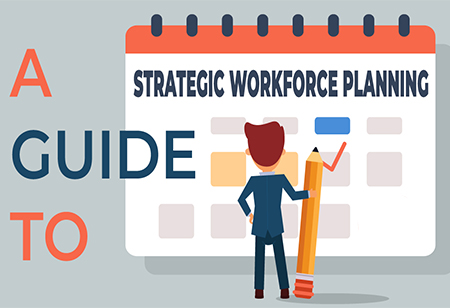The Importance Of Strategic Workforce Planning In An Organization
By Aveek Pal Chaudhuri
 In any organization, strategic workforce is done to meet the future needs. It is done to make sure that there is the right person available for a specific job at any given time, while maintaining the exact proportion of workers to avoid overstaffing or understaffing. Strategic planning aims to make sure workers are regularly aligned to the business objectives. But due to a shortage of skilled workers, it is becoming difficult for businesses to achieve the production goals or revenue goals. Where skilled workers construct the strong platform for a company to build an everlasting impression, this shortage is resulting into damage of that platform. Amidst of growing economy in India, there has been a constant voice against unemployment. The Periodic Labour Force Survey (PLFS) of the National Sample Survey Office (NSSO) stated that the unemployment rate in Fiscal Year 2018 was around 5.3 percent in the rural part of the country, whereas it reached 7.8 percent in the urban areas. The overall unemployment rate is 6.1 percent. Therefore, organizations need to have a strategize workforce planning, both for the benefit of the organization and the unemployed skilled workers.
In any organization, strategic workforce is done to meet the future needs. It is done to make sure that there is the right person available for a specific job at any given time, while maintaining the exact proportion of workers to avoid overstaffing or understaffing. Strategic planning aims to make sure workers are regularly aligned to the business objectives. But due to a shortage of skilled workers, it is becoming difficult for businesses to achieve the production goals or revenue goals. Where skilled workers construct the strong platform for a company to build an everlasting impression, this shortage is resulting into damage of that platform. Amidst of growing economy in India, there has been a constant voice against unemployment. The Periodic Labour Force Survey (PLFS) of the National Sample Survey Office (NSSO) stated that the unemployment rate in Fiscal Year 2018 was around 5.3 percent in the rural part of the country, whereas it reached 7.8 percent in the urban areas. The overall unemployment rate is 6.1 percent. Therefore, organizations need to have a strategize workforce planning, both for the benefit of the organization and the unemployed skilled workers.
As workforce is regarded as the most important aspect of an organization to multiply its revenue, but if it does not have the proper workforce, it will not be able to do so. Moreover, strategized workforce planning helps in avoiding unpredicted business situations for long-term success. The MIS (Management Information System) report helps organizations to adopt necessary workforce measurements prior to business breakdowns.
Basic Philosophy of Workforce Planning:
- Strategic workforce planning will always dictate a company to achieve long-term goals by analyzing the present workforce.
- Strategic workforce planning will always focus on the primary functions of an organization that are valuable for it.
- It will help in determining the future direction of a company with the current products and services.
- Determines the quality of the workforce – Whether it is highly performing or have high-potential to perform magnificently in the future. Many companies spend much time and money to go to the extreme extent for utilizing the full potential of the employees.
- Another very important factor is identifying the right quantity of workforce needed to perform the overall tasks.
According to the United States OPM (United States Office of Personal Management), there are 5 necessary steps for a proper workforce planning, which are:
- Set Strategic Direction
- Analyze Workforce and Identify Skill Gaps
- Develop Action Plan
- Implement Action Plan
- Monitor, Evaluate and Revise
According to this US OPM model, strategic workforce planning provides benefits like employee retention, talent identification, skill gap determination, and budgeting. If a strategic workforce planning is executed properly, then it can act as a beneficiary for businesses in many ways. It can curb unnecessary costs and other business disruptions.
Some of the benefits of strategic workforce planning are:
- While many businesses face problems to make budgets and later implementing it, strategic workforce planning in an organization supports the overall budgeting process whenever needed. If executed at the right time, strategic workforce planning makes budget making easier and manageable.
- Strategic workforce planning helps in hiring process. If a potential worker with shortage of industry relevant skills gets recruited, strategic workforce planning comes in rescue of that worker by enhancing the skills of the worker.
- As mentioned, strategic workforce planning helps in employee retention in areas where there are high turnovers.
- Helps in identifying the right talent and promotes communication between business units and human resources.
- It secures the future of an organization with a pool of talents. Specifically, strategic workforce planning helps in identifying staffing requirements and helps in the identification of training and development needs for a long run.







